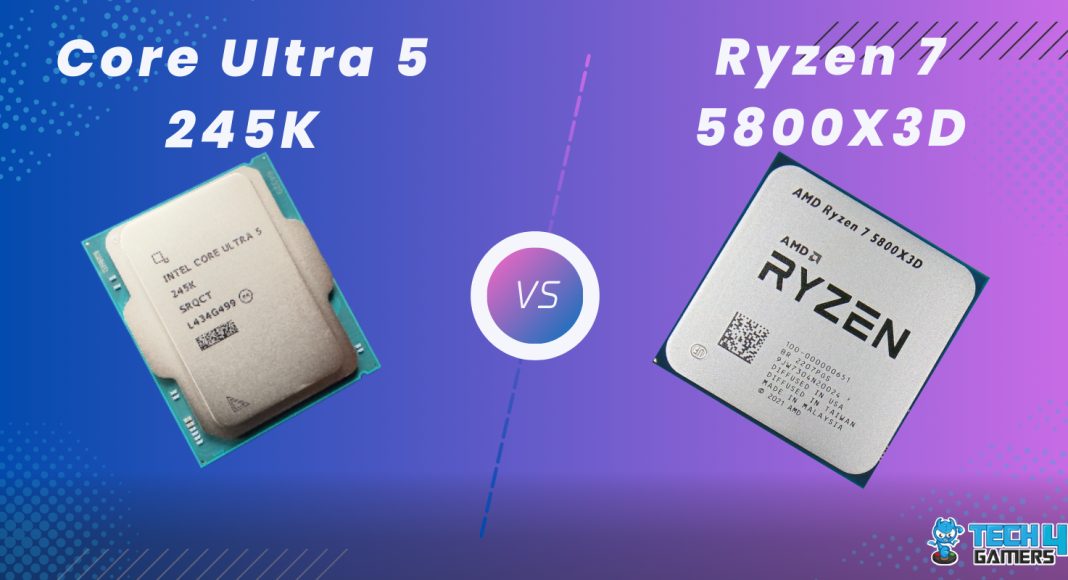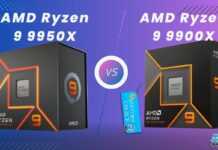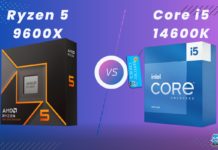AMD Ryzen 7 5800X3D Rated: 7.9/10 Intel Core Ultra 5 245K Rated: 8/10
Pros And Cons
| CPU | Pros | Cons |
|---|---|---|
| Ryzen 7 5800X3D | ✅ Has 73 MB larger L3 cache size ✅ Better in terms of performance | ❌ Lower power consumption |
| Core Ultra 5 245K | ✅ Has 6 more physical cores ✅ More modern manufacturing process | ❌ Worse in terms of performance |
Comparison Table
| Feature | Core Ultra 5 245K | Ryzen 7 5800X3D |
|---|---|---|
| Instruction Set | x86-64 | x86-64 |
| Codename | Arrow Lake | Zen 3 (Vermeer) |
| Model number | 245K | - |
| Integrated GPU | Arc Xe2 (Arrow Lake-S) | No |
| Transistors | 17.8 billions | - |
| Fabrication Process | 3 nm | 7 nm |
| Best Motherboards | - | Best Motherboards for Ryzen 7 5800X3D |
| Best CPU Coolers | - | Best CPU Coolers For Ryzen 7 5800X3D |
| Best RAM | - | Best RAM For Ryzen 7 5800X3D |
| Processor Review | Intel Core Ultra 5 245K Review | - |
Architectural Differences
- Core Count: The 245K has 14 cores (6 performance and 8 efficiency) and 14 threads, compared to 8 cores and 16 threads in the 5800X3D.
- Clock Speed: The base frequency of the Core Ultra is about 4.2GHz, whereas the 5800X3D has a base clock of 3.4GHz. The boost clock is 5.2GHz on the 245K, while the 5800X3D boosts to 4.5GHz.
- Process Node: The 5800X3D is an older processor with a 7nm manufacturing process, while the 245K has a 3nm manufacturing process.
- TDP: Though Intel has boasted great power claims, the 245K has a TDP of 125 watts, which is a bit higher than the 5800X3D’s 105-watt TDP.
- Cache: The 5800X3D has a large L3 cache buffer of 96 megabytes, whereas the 245K has a 24-megabyte buffer.
The AMD X3D line stands out with impressive performance and efficiency, outperforming even top-tier competitors. In the Core Ultra 7 245K vs Ryzen 7 5800X3D comparison, we will see if Intel’s latest release holds up to the processor that started it all!
Gaming Benchmarks
In this section of the comparison, we will see how these two chips perform each other when we put them head-to-head in gaming tests. These tests were conducted on a measured test bench, the specs of which are written below:
Test Bench
- OS – Windows 11
- RAM 1 – G.Skill Trident Z5 RGB 32GB DDR5-6600
- RAM 2 – Patriot Viper LED DDR4-3600 16GB RAM
- CPU Cooler: Noctua NH-U12S SE-AM4
- Graphics Card – GIGABYTE RTX 4090 Gaming OC 24G
- SSD – CORSAIR MP700 PRO 2TB
- Power Supply – be quiet! Dark Power Pro 13 1300W
Star Wars Jedi: Survivor

- In this Star Wars title, the 5800X3D had a framerate of 162 FPS, which was about 13% greater than the 143 FPS that the Core Ultra 5 245K managed to sustain.
- The minimums showed a difference closer to 14%, with the 5800X3D dropping to around 141 FPS in some scenes, whereas the 245K hovered closer to about 124 FPS.
The Last Of Us Part 1

- There was a 13% difference in our test of this PS port, with the 245K getting a framerate of 179 FPS, while the 5800X3D hovered closer to about 158 FPS.
- We saw a difference of around 23% in the 1% lows, where the 245K got a framerate of 134 FPS, while the 5800X3D dipped to around 109 FPS in our testing.
Cyberpunk 2077

- Framerates were around 164 FPS on the 5800X3D, which was about 22% higher than the 134 FPS of the Core Ultra 5 245K when we tested Cyberpunk 2077.
- The 5800X3D managed 1% lows of around 117 FPS in the hard-to-render scenes, whereas the 245K went down to around 101 FPS.
Hogwarts Legacy

- The 245K came out ahead, with an average framerate of about 115 FPS, whereas the 5800X3D got a framerate closer to 110 FPS in our testing, showcasing a 4.5% difference.
- The 5800X3D’s framerate dropped to around 68 FPS in the 1% lows, whereas the 245K had a 19% higher framerate of 81 FPS.
Remnant 2

- In our testing, there was a small difference between these two chips. The 5800X3D got an average framerate of about 108 FPS, while the 245K was two frames ahead with a framerate of 110 FPS.
- The 1% lows pulled a few frames ahead, with the 245K getting lows of 97 FPS in our testing, which was about 7% higher than the 5800X3D’s 91 FPS.
Homeworld 3

- There was an 11% difference in Homeworld 3, where the 5800X3D got a framerate of 90 FPS on average in our testing, whereas the 245K hovered closer to 81 FPS.
- The 47 FPS rendered by the 5800X3D in the lows gave it a big 74% lead over the 245K in this game. The Intel processor could only manage 27 FPS as a minimum.
A Plague Tale: Requiem

- The 5800X3D got a framerate of 144 FPS as its average in A Plague Tale, which was 20% higher than the 120 FPS that the 245K managed.
- The minimums were around 106 FPS on the 5800X3D, while the 245K was 45% behind with a framerate of only 73 FPS.
Hitman 3

- Finally, the last game of our testing showed that the 5800X3D had a framerate of around 214 FPS on average, about 8% lower than the 232 FPS of the 245K.
- The minimum framerates were about 7% higher on the Intel chip at around 206 FPS, while the 5800X3D hovered around 192 FPS.
Productivity Benchmarks
Now that we have taken a look at how these chips perform in gaming tests, the following few sections will focus on the productivity performance of the Core Ultra 7 245K vs Ryzen 7 5800X3D. The setup we used for these tests is the same as the one we used for the gaming benchmarks.
Cinebench

- The 245K had a single-core performance of only 137 points, which was about 44% higher than the 5800X3D’s 95 points.
- In the multi-core test, the 5800X3D got a total of 858 points, which was massively lower than the 1522 points that the Core Ultra had. This difference translates to a 77% lead for the Intel chip.
7-Zip

- In the compression test, the 5800X3D scored a total of 89 points, while the 245K had a performance of 134 points, leading to about a 50% lead.
- In the decompression test, the 5800X3D had a score of 116 points, which was only 4% lower than the 121 points that the 245K achieved.
Photoshop

- Finally, Photoshop also ran much better on the 245K. The Core Ultra was about 21% faster than the 5800X3D in this test.
- The Core Ultra 245K got a score of 10465 points in the Pudget systems test in Photoshop, while the 5800X3D got only 8638 points.
Overall Performance
Average Framerates
In the congregated average framerates, the 5800X3D came out ahead but only by a very small margin. The 5800X3D was only about 3% faster than the 245K, which is good news because it means Intel’s budget CPUs are catching up to the performance of the legendary first X3D chip.
1% Lows
The difference in the averages carried over almost one-to-one when it came to the lows, with the 5800X3D being ahead by only 3% as well. Though this is, once again, great for the Intel chip, it means that the 5800X3D has started to show its age.
Performance
As we expected, the 245K crushed it in these tests. It came out leaps and bounds ahead of the 5800X3D in all the tests we ran. The X3D chips weren’t ever known for their productivity performance, and these tests reminded us why this is.
Power Consumption
| Game | Ryzen 7 5800X3D | Core Ultra 5 245K |
|---|---|---|
| Star Wars Jedi: Survivor | 68 | 73 |
| The Last Of Us Part 1 | 67 | 71 |
| Cyberpunk 2077 | 68 | 74 |
| Hogwarts Legacy | 66 | 73 |
| Remnant 2 | 67 | 70 |
| Homeworld 3 | 65 | 69 |
| A Plague Tale: Requiem | 68 | 73 |
| Hitman 3 | 67 | 71 |
| Average Power Draw | 67⚡ | 71.75⚡ |
| Winner: Ryzen 7 5800X3D | ||
In our power consumption tests, the Ryzen 7 5800X3D came out ahead even though the Core Ultra had 2 extra years to catch up to this level of efficiency. This difference is small, though, with the 5800X3D only consuming about 7% less power than the Core Ultra 5 245K.
Temperatures
| Game | Ryzen 7 5800X3D | Core Ultra 5 245K |
|---|---|---|
| Star Wars Jedi: Survivor | 67 | 68 |
| The Last Of Us Part 1 | 65 | 64 |
| Cyberpunk 2077 | 66 | 76 |
| Hogwarts Legacy | 65 | 78 |
| Remnant 2 | 67 | 67 |
| Homeworld 3 | 68 | 65 |
| A Plague Tale: Requiem | 64 | 68 |
| Hitman 3 | 67 | 64 |
| Average Temperatures | 66.12🌡️ | 68.75🌡️ |
| Winner: Ryzen 7 5800X3D | ||
The Core Ultra ran about 4% hotter in our test, though both of these processors were completely in safe temperature ranges. Neither of these chips ran too hot in our testing, and we think these temperatures should not be factored into the buying decision because of their very low difference.
Price And Availability
| CPU | Ryzen 7 5800X3D | Core Ultra 5 245K | Price Difference |
|---|---|---|---|
| Launch MSRP | 💲499 | 💲319 | 56.43% |
| Current Price | 💲309 | 💲299 | 3.34% |
Both these chips are about the same price at the moment, with the 5800X3D being only around 3% more expensive than the Core Ultra 5 245K. This makes us believe that the 245K is fairly priced, though it won’t be winning any bang-for-your-buck awards.
What We Recommend
Core Ultra 5 245K: After going through all these factors in this comparison, we can safely say that the Core Ultra 5 245K is not a bad deal. Yes, it only beats the 2-year-old chip in productivity and almost matches it in gaming, but for the benefits you get with the 245K being a new chip, it might be worth it for a lot of people.
Ryzen 7 5800X3D: The oldness of this chip is a marvel, as it still outperforms recent processors. It performed better in the gaming tests, the power consumption is still excellent, and the price has decreased to be passable in this day and age, though we’d still like to see it go down further.
The 245K is a close competitor to the 5800X3D in the gaming tests, while it massively outperforms it in productivity. From this, we can say that the 245K is the better deal, though you might be able to find a 5800X3D pretty cheap on the used market, in which case the tables turn.
More From Ryzen 7 5800X3D
Thank you! Please share your positive feedback. 🔋
How could we improve this post? Please Help us. 😔
[Comparisons Expert]
Shehryar Khan, a seasoned PC hardware expert, brings over three years of extensive experience and a deep passion for the world of technology. With a love for building PCs and a genuine enthusiasm for exploring the latest advancements in components, his expertise shines through his work and dedication towards this field. Currently, Shehryar is rocking a custom loop setup for his built.
Get In Touch: shehryar@tech4gamers.com







![RX 6600 XT Vs RTX 3050 [9 AAA Games Tested]](https://tech4gamers.com/wp-content/uploads/2023/02/Comparison-4-218x150.jpg)